IAN helping to plan and establish multiple Marine Protected Areas (MPAs) in Indonesia
 Jane Thomas from IAN has been in Bali working with The Nature Conservancy (TNC). Together with Conservation International and World Wildlife Fund, TNC has been helping the Indonesian government to plan and establish multiple Marine Protected Areas (MPAs) in the Bird's Head/Raja Ampat region of Indonesia's West Papua province. This region is in the heart of the Coral Triangle, which is the center of the highest coral diversity in the world. Surveys around Raja Ampat show that this area has the highest marine biodiversity on earth. IAN has been working with TNC to develop a series of conceptual diagrams depicting the benefits of MPAs for the reefs and wildlife, and the communities that depend on them for sustenance and livelihood. The major threats to the Bird's Head/Raja Ampat region are unsustainable fishing (including longlines, shark finning, dynamite and cyanide fishing), logging (causing erosion), and mining.
Jane Thomas from IAN has been in Bali working with The Nature Conservancy (TNC). Together with Conservation International and World Wildlife Fund, TNC has been helping the Indonesian government to plan and establish multiple Marine Protected Areas (MPAs) in the Bird's Head/Raja Ampat region of Indonesia's West Papua province. This region is in the heart of the Coral Triangle, which is the center of the highest coral diversity in the world. Surveys around Raja Ampat show that this area has the highest marine biodiversity on earth. IAN has been working with TNC to develop a series of conceptual diagrams depicting the benefits of MPAs for the reefs and wildlife, and the communities that depend on them for sustenance and livelihood. The major threats to the Bird's Head/Raja Ampat region are unsustainable fishing (including longlines, shark finning, dynamite and cyanide fishing), logging (causing erosion), and mining.
IAN begins new partnership with Conservation International
 The Integration & Application Network will be working with Conservation International on a series of booklets and guidebooks on their Marine Management Area Science (MMAS) program. The program has been working for four years on a variety of studies around the world, including socioeconomic, ecosystem health monitoring, and governance projects. These projects, based at nodes in Panama, Belize, Brazil and Fiji, will be synthesized into a variety of products that will be used by practitioners and policy makers. For example, Conservation International and IAN convened a workshop in November to mock up a booklet on People & Oceans, which focuses on MMAS program research results on the socio-cultural and economic well-being of coastal communities and society.
The Integration & Application Network will be working with Conservation International on a series of booklets and guidebooks on their Marine Management Area Science (MMAS) program. The program has been working for four years on a variety of studies around the world, including socioeconomic, ecosystem health monitoring, and governance projects. These projects, based at nodes in Panama, Belize, Brazil and Fiji, will be synthesized into a variety of products that will be used by practitioners and policy makers. For example, Conservation International and IAN convened a workshop in November to mock up a booklet on People & Oceans, which focuses on MMAS program research results on the socio-cultural and economic well-being of coastal communities and society.
Science of Marine Managed Areas
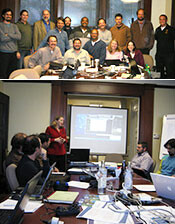 Continuing work with Conservation International's Marine Management Area Science (MMAS) program, Bill Dennison, Tim Carruthers, Caroline Wicks, and Jane Thomas from IAN and Ecocheck attended workshops in Boston in December 2009 and January 2010. IAN staff worked with the lead scientists from the different project components, summarizing results from the node field sites in Panama, Brazil, Fiji, and Belize. The outcomes of the workshops were drafts of synthesis products from the MMAS program: (1) 'Ecological monitoring', which will be a four-page policy brief summarizing monitoring of coral reefs at the node sites; (2) 'Living with the Seas', which will be a booklet summarizing the ecological effects and implications of marine managed areas; and (3) 'Community Health Index', which will be a booklet on the development of a health assessment tool for coral reefs.
Continuing work with Conservation International's Marine Management Area Science (MMAS) program, Bill Dennison, Tim Carruthers, Caroline Wicks, and Jane Thomas from IAN and Ecocheck attended workshops in Boston in December 2009 and January 2010. IAN staff worked with the lead scientists from the different project components, summarizing results from the node field sites in Panama, Brazil, Fiji, and Belize. The outcomes of the workshops were drafts of synthesis products from the MMAS program: (1) 'Ecological monitoring', which will be a four-page policy brief summarizing monitoring of coral reefs at the node sites; (2) 'Living with the Seas', which will be a booklet summarizing the ecological effects and implications of marine managed areas; and (3) 'Community Health Index', which will be a booklet on the development of a health assessment tool for coral reefs.
Adapting to climate change: maintaining ecosystem services for human well-being in the Verde Island Passage, Philippines
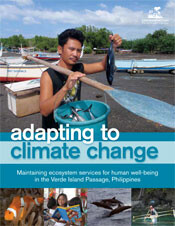 IAN's collaboration with Conservation International has produced this report and an accompanying newsletter on the effects of climate change in this region of the Philippines. The Verde Island Passage, located in the Coral Triangle—an area considered the center of the world's marine biodiversity—has a wealth of marine resources on which rests the livelihoods of millions of people, and which are vulnerable to increasing sea surface temperatures, sea levels, ocean acidity, storm activity, and rainfall.
IAN's collaboration with Conservation International has produced this report and an accompanying newsletter on the effects of climate change in this region of the Philippines. The Verde Island Passage, located in the Coral Triangle—an area considered the center of the world's marine biodiversity—has a wealth of marine resources on which rests the livelihoods of millions of people, and which are vulnerable to increasing sea surface temperatures, sea levels, ocean acidity, storm activity, and rainfall.
Conservation International booklets released
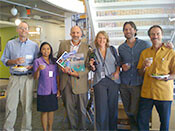 Conservation International has been working with IAN staff to develop a series of publications regarding Marine Managed Areas as part of their Science to Action program. The first three booklets in a publication series were released in September. "People and Oceans: Managing marine areas for human well-being" (20 pp.) provides a social and economic perspective on marine managed areas. "Living with the Sea: Local efforts buffer effects of climate change" provides a natural science perspective on marine managed areas. "Marine Managed Areas: What, why and where" (16 pp.) provides a description of this management approach. Each booklet is rich in illustrations and uses multiple case studies from a global effort by Conservation International to develop and test marine management approaches.
Conservation International has been working with IAN staff to develop a series of publications regarding Marine Managed Areas as part of their Science to Action program. The first three booklets in a publication series were released in September. "People and Oceans: Managing marine areas for human well-being" (20 pp.) provides a social and economic perspective on marine managed areas. "Living with the Sea: Local efforts buffer effects of climate change" provides a natural science perspective on marine managed areas. "Marine Managed Areas: What, why and where" (16 pp.) provides a description of this management approach. Each booklet is rich in illustrations and uses multiple case studies from a global effort by Conservation International to develop and test marine management approaches.
Conservation International policy briefs released
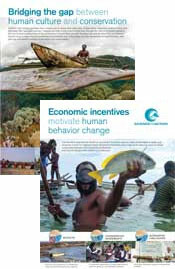 Two new policy briefs, resulting from a collaboration between IAN staff and Conservation International's Science to Action program, have just been released. "Economic Incentives Motivate Human Human Behavior Change" features the three approaches to providing economic incentives to conserve natural resources. Tips for designing a successful incentive program are described. "Bridging the Gap Between Human Culture and Conservation" examines the relationship between coastal communities and the marine resources they depend on, both in the culture, economies, and lifestyles of the people. Four countries with marine managed areas are highlighted.
Two new policy briefs, resulting from a collaboration between IAN staff and Conservation International's Science to Action program, have just been released. "Economic Incentives Motivate Human Human Behavior Change" features the three approaches to providing economic incentives to conserve natural resources. Tips for designing a successful incentive program are described. "Bridging the Gap Between Human Culture and Conservation" examines the relationship between coastal communities and the marine resources they depend on, both in the culture, economies, and lifestyles of the people. Four countries with marine managed areas are highlighted.
Conservation International Economic Incentives Guidebook released
 Conservation International has been working with IAN staff to develop a series of publications regarding Marine Managed Areas as part of their Science to Action program. The next report in the publication series was just released. The Economic Incentives Guidebook (40 pp.) provides details on designing effective economic incentives in order to motivate sustainable human behavior relative to marine managed areas. Twenty-seven case studies worldwide are summarized.
Conservation International has been working with IAN staff to develop a series of publications regarding Marine Managed Areas as part of their Science to Action program. The next report in the publication series was just released. The Economic Incentives Guidebook (40 pp.) provides details on designing effective economic incentives in order to motivate sustainable human behavior relative to marine managed areas. Twenty-seven case studies worldwide are summarized.
Coral Health Index (CHI): measuring coral community health
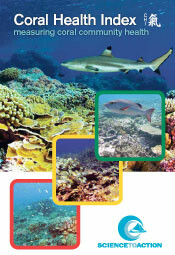 Effective local management of coral reefs has a direct effect on reducing threats and improving overall coral community health. Careful zoning and effective enforcement of resource use within a marine managed area reduces impact of overfishing, allowing populations of grazing fish to rejuvenate and maintain healthy ecosystem functioning. Coral reefs that are healthy have greater resilience and ability to recover from chronic and acute stress. Adaptive management of coral reef communities will be most effective if a reliable annual indicator of community health is available to resource managers and policy makers. The Coral Health Index (CHI), developed by Conservation International's Science-to-Action partnership, is just such a tool.
Effective local management of coral reefs has a direct effect on reducing threats and improving overall coral community health. Careful zoning and effective enforcement of resource use within a marine managed area reduces impact of overfishing, allowing populations of grazing fish to rejuvenate and maintain healthy ecosystem functioning. Coral reefs that are healthy have greater resilience and ability to recover from chronic and acute stress. Adaptive management of coral reef communities will be most effective if a reliable annual indicator of community health is available to resource managers and policy makers. The Coral Health Index (CHI), developed by Conservation International's Science-to-Action partnership, is just such a tool.
Science-to-Action Guidebook
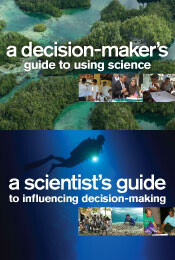 Recognizing the importance of informed decisions and the differences between the scientific and decision-making processes, this guidebook provides practical tips on how to best bring these worlds together. It emphasizes the roles of facilitating, synthesizing, translating, and communicating science to inform conservation action. The two "guides" are combined in one publication: one intended for scientists, and the other for decision-makers. Visit the Science to Action website for printed copies and further information.
Recognizing the importance of informed decisions and the differences between the scientific and decision-making processes, this guidebook provides practical tips on how to best bring these worlds together. It emphasizes the roles of facilitating, synthesizing, translating, and communicating science to inform conservation action. The two "guides" are combined in one publication: one intended for scientists, and the other for decision-makers. Visit the Science to Action website for printed copies and further information.
9th Pacific Islands Conference on Nature Conservation and Protected Areas
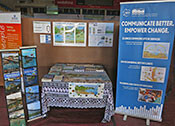 IAN staff attended the 9th Pacific Islands Conference on Nature Conservation and Protected Areas in Fiji in early December, setting up our first IAN conference booth. Our booth proved extremely popular, with almost all of our materials ravaged by the end of the first day! The conference itself was a fantastic opportunity to meet Pacific-based colleagues that we've worked with virtually, and to catch up with others. IAN diagrams and reports were featured in several keynote presentations and workshops throughout the conference, and we've started lining up potential new collaborations for the next few years. The word is getting out!
IAN staff attended the 9th Pacific Islands Conference on Nature Conservation and Protected Areas in Fiji in early December, setting up our first IAN conference booth. Our booth proved extremely popular, with almost all of our materials ravaged by the end of the first day! The conference itself was a fantastic opportunity to meet Pacific-based colleagues that we've worked with virtually, and to catch up with others. IAN diagrams and reports were featured in several keynote presentations and workshops throughout the conference, and we've started lining up potential new collaborations for the next few years. The word is getting out!

